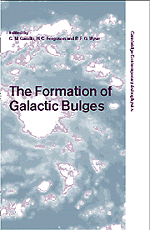Book contents
- Frontmatter
- Contents
- Preface
- Dedication: In Memory of Olin Eggen
- Part 1 Introduction
- Part 2 The Epoch of Bulge Formation
- Part 3 The Timescales of Bulge Formation
- Part 4 Physical Processes in Bulge Formation
- Part 5 Bulge Phenomenology
- Bulge-Disk Decomposition of Spiral Galaxies in the Near-Infrared
- The Triaxial Bulge of NGC 1371
- The Bulge-Disk Orthogonal Decoupling in Galaxies: NGC 4698 and NGC 4672
- The Kinematics and the Origin of the Ionized Gas in NGC 4036
- Optically Thin Thermal Plasma in the Galactic Bulge
- X-Ray Properties of Bulges
- The Host Galaxies of Radio-Loud AGN
- The Centers of Radio-Loud Early-Type Galaxies with HST
- Central UV Spikes in Two Galactic Spheroids
- Part 6 Conference Summary
- Index
Bulge-Disk Decomposition of Spiral Galaxies in the Near-Infrared
from Part 5 - Bulge Phenomenology
Published online by Cambridge University Press: 10 November 2010
- Frontmatter
- Contents
- Preface
- Dedication: In Memory of Olin Eggen
- Part 1 Introduction
- Part 2 The Epoch of Bulge Formation
- Part 3 The Timescales of Bulge Formation
- Part 4 Physical Processes in Bulge Formation
- Part 5 Bulge Phenomenology
- Bulge-Disk Decomposition of Spiral Galaxies in the Near-Infrared
- The Triaxial Bulge of NGC 1371
- The Bulge-Disk Orthogonal Decoupling in Galaxies: NGC 4698 and NGC 4672
- The Kinematics and the Origin of the Ionized Gas in NGC 4036
- Optically Thin Thermal Plasma in the Galactic Bulge
- X-Ray Properties of Bulges
- The Host Galaxies of Radio-Loud AGN
- The Centers of Radio-Loud Early-Type Galaxies with HST
- Central UV Spikes in Two Galactic Spheroids
- Part 6 Conference Summary
- Index
Summary
A method for fitting the near-infrared surface brightness distribution of spiral galaxies by two-dimensional disk- and bulge-functions is presented. First results for a sample of 40 spirals are shown.
Introduction
An important tool for galaxy research is the study of the surface brightness (SB) distribution. For spiral galaxies the determination of the scale length of the exponential disk has a long traditition (e.g. Courteau 1996). However, the errors in these results are still rather large (Knapen & van der Kruit 1991).
For a better understanding of spiral galaxies it is necessary to study the structure of both disk and bulge as well. In order to separate non-axisymmetric structures as bars or triaxial bulges from the axisymmetric disk, two-dimensional fits are advantageous (e.g. de Jong 1996). In the following I present a generalization of a nonlinear direct fit method to the two-dimensional SB distribution of near-infrared (NIR) images of spiral galaxies.
NIR Data
The aim of this project is the study of the distribution of the mass-carrying evolved stars in spiral galaxies of different Hubble types. For this purpose, NIR observations are advantageous since they have much less perturbations due to dust or especially bright young stars.
The observations were performed during several runs at the 2.2m telescope of the German-Spanish observatory on Calar Alto, Spain. The detector was the MAGIC-NIR-camera with a NICMOS chip of (0.67″) 256×256 pixels, for a total field of view of ≈ 3′ × 3′.
- Type
- Chapter
- Information
- The Formation of Galactic Bulges , pp. 157 - 160Publisher: Cambridge University PressPrint publication year: 2000



